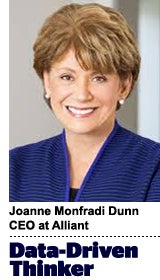“Data-Driven Thinking” is written by members of the media community and contains fresh ideas on the digital revolution in media.
Today’s column is written by JoAnne Monfradi Dunn, CEO at Alliant.
Brands are attracted to audience targeting because it helps them home in on customers and prospects that represent likely buyers and the highest return on their advertising investments. The tool of choice for achieving this, in almost every channel, is modeling.
But models, especially machine-driven programmatic models and AI, are by their nature exclusionary. That’s good in the sense that the model is using available first- and third-party data sources to select audiences most likely to respond to the advertising. But without careful scrutiny, such models may inadvertently target consumers using innocent characteristics that exclude demographic groups.
Avoiding unintentional exclusion means that brands must plan for and seek diverse audiences that have been assembled intentionally.
Right now, there is no convenient mechanism for evaluating whether an off-the-shelf audience is inclusive and/or diverse, short of reaching out to providers directly for a transparent breakdown. But that takes time and isn’t always possible. Even with an answer, it’s possible that the mix doesn’t meet a brand’s inclusivity benchmarks.
Making audiences better
Many brands turn to custom modeling to ensure that audiences align with their campaign goals – and, increasingly, their social mission.
Custom audiences are hardly new, and while they’re widely available, they are not the dominant way of targeting campaigns, because their construction requires more time, thought and investment. Building custom audiences can encourage transparent conversations about model inputs, from initial segmentation to variable selection.
What does a responsible and inclusive audience look like? Delivering socially conscious and responsible audiences requires stakeholders to think carefully about the audience they wish to target, the segmentation assumptions that govern and the variables employed in modeling.
Changing some simple “standard operating procedures” can have an immediate impact:
Examine look-alike seed audiences
Do look-alike seed audiences represent a diverse composition of consumers? If not, consider expanding acquisition audience selection criteria. Many look-alike audiences are modeled from existing customers or social followers. If a diversity assessment of a customer file reveals a homogenous audience, marketers should look outside of their CRM.
A social profile of existing customers could identify other brands, retailers and influencers they engage with. Also look for brands with more inclusive customer bases and tap into the affinity shared with your brand.
For example, a beauty brand targeting a millennial audience for cosmetic products may investigate who its audience engages with on social to inspire new sources of diversity for its seed files. Perhaps its audience follows other beauty brands such as NARS and Fenty Beauty, but they also have a high affinity for athletic wear brands such as Fabletics. Integrating these insights into look-alike development seeds can create a more diverse representation of consumers who may have an affinity for its brand.
Eliminate variables that may arbitrarily exclude certain types of consumers
Marketers should initiate a conversation with their analytics team about their targeting assumptions and what changing them could mean to the brand. Some variables do inadvertently exclude certain consumer demographics. Common metrics such as percentage of home ownership within a block group, sports interests or some product preferences can skew audience selection across income, gender or ethnic lines, keeping messaging from reaching certain profiles. Data scientists have tests for identifying this kind of bias and can take steps to eliminate it. This practice is common in financial services, where laws such as the Fair Housing Act specifically prohibit excluding consumers on the basis of race, religion, familial status and other sensitive attributes.
It is important to make sure the resulting audience is reviewed for diversity assurance before it is pushed. Brands should take a look at their custom modeled audiences and apply an improved understanding of their brand’s diversity goals. Did previous models inadvertently include variables that impacted audience diversity? They can use these insights to identify variables that may cause unintended bias and ensure they are removed from future campaigns.
If custom is too great an investment, try broadening segment selections in standard targeting
With tremendous shifts in consumer behavior since the pandemic, now is a great time to test audience boundaries. For example, grocery and food delivery brands have seen expanded activity in suburban and rural areas, as well as an increase in consumers’ average age. Therefore, it makes sense to explore expanded ZIP codes and increased age ranges. From there, brands can monitor performance from new test segments and keep notes on differences in the makeup of their audiences.
They may quickly find that a broadened audience will not only increase diversity, but also reward them with new customers.
A new level of commitment
The strategy and back-and-forth conversations required to build more inclusive audiences may feel as if they’re slowing the pace of a campaign. But if brands take time and energy to develop creative strategies that broaden messaging, and then grab a flawed audience off the shelf at the last minute, what was the point of the changes?
Speed to market hardly matters if a message of change isn’t seen by those most likely to respond to it or those who really need to see it.
Follow Joanne Monfradi Dunn (@JoDunn4Alliant), Alliant (@AlliantInsight) and AdExchanger (@adexchanger) on Twitter.













